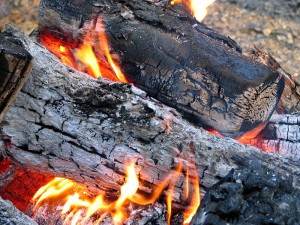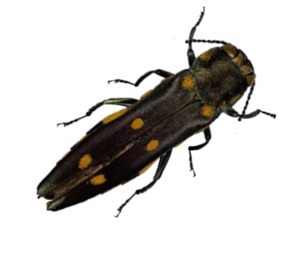 Examples abound of pest spread by this means:
Examples abound of pest spread by this means:
• Emerald ash borer: outbreaks near campgrounds in West Virginia, Missouri, New Hampshire, and many other states.
• Goldspotted oak borer: initial outbreak at campgrounds in Cleveland National Forest in San Diego County. Subsequently, outbreaks distant from the original site have been detected in Idyllwild in Riverside County, Weir Canyon in Orange County, and in Green Valley in Los Angeles County.
• Redbay ambrosia beetle and associated laurel wilt disease: outbreaks in Everglades National Park and in Texas.
It is widely believed that many other geographically distant outbreaks of damaging pests have been caused by movement of firewood.
About half the states have adopted regulations governing movement of firewood in order to reduce the risk that moving firewood can spread non-native, tree-killing insects far from existing outbreaks to new, vulnerable forests. Among states at greatest risk are states of the central South – Texas, Arkansas, Missouri; and California. All these states are at high risk due to numbers of campers visiting sites on their territories & growing presence of wood-boring pests.
A study by USDA Forest Service researcher Frank Koch and others found that the highest level of camper travel in the U.S. was to lakes and reservoirs in National forests in an area reaching from eastern Texas to Missouri. Arkansas and Missouri regulate hardwood firewood entering the state because of risk of transporting thousand cankers disease of walnut. Both also have internal state quarantines for emerald ash borer; movement of hardwood firewood from within those quarantine zones is prohibited. Firewood from the southern portion of Arkansas is also subject to quarantines intended to prevent movement of the red imported fire ant.
Texas also regulates firewood stored outside in red imported fire ant quarantine; this quarantine applies to all of the forested areas of the state, so presumably movement of firewood within this large area is allowed. The absence of regulations does not address the threat from one firewood-associated pest – the soapberry borer – already widespread in Texas; nor the increasing risk from EAB, which is established in several neighboring states (see link above). Texas ash is an important component of forest in hill country. Texas ash is a key food for prey fed to nestlings of the endangered golden-cheeked warbler.
If Texas becomes a bridge by which EAB reaches Mexico, another dozen species of ash will be at risk.
California also does not regulate movement of firewood either generally or by visitors to state parks (see my blog of September 27). California does regulate movement of firewood into the state. And the California Department of Food and Agriculture and CalFire do invest significant resources in outreach and education efforts asking Californians not to move firewood.
In October, Dr. David Wood, emeritus professor of forest insects at UC Berkeley, and I submitted a petition to the California Department of Food and Agriculture asking that it regulate movement of firewood in the state. We cited specifically the recent detection of a new outbreak of the goldspotted oak borer at Green Valley in Los Angeles County.

In our petition, we acknowledged that CDFA has been active in outreach programs urging Californians not to move firewood. We said that we feared that the educational effort could not succeed in the absence of regulations. First, the lack of regulation allows firewood vendors to ignore the educational message, since there is no sanction. At a deeper level, failure to regulate also conveys an impression that the risk associated with firewood is not considered sufficiently serious to warrant an official response.
In November, CDFA denied our petition. The agency cited the fact that the GSOB detection did not occur until perhaps 20 years after its initial introduction; the absence of pests in firewood from Arizona and Mexico inspected at California border stations; the failure of the federal quarantines targeting EAB to slow that insect’s spread; the insect’s own flight capacity; and – especially – the large number of people moving firewood and other possible vectors of the insect around the state. CDFA re-iterated its belief that the most effective response combines research to develop better detection and management tools public outreach and education.
Of course, numerous other pests are transported in firewood, not just GSOB. These include Polyphagous and Kushiro shot hole borers, pitch canker of pines, sudden oak death, as well as such native insects as the mountain pine beetle.
All these states urge campers to obtain firewood near where they will burn it.
However, I think all are ignoring the lesson from Wisconsin – regulations restricting movement of firewood back up education by providing “teachable moments” and penalizing those who willfully disregard the warnings. To learn about Wisconsin’s successful application of a combination of regulations and outreach, watch the webinar presented by Andrea Diss-Torrance at http://dontmovefirewood.org/blog/webinar-changing-movement-firewood-campers-october-21st.html
Federal agencies also are not doing all they should – as I noted in my blog of August 10. USDA APHIS has enacted quarantines targeting particular species, such as the Asian longhorned beetle and emerald ash borer. APHIS also helps to fund significant outreach efforts, both through the Don’t Move Firewood website and associated programs and working with NASCAR and other sponsors of big events attended by lots of campers. However, APHIS’ plan to control movement of pests in firewood sold in bulk by large suppliers to large retail outlets by developing an industry certification program has been in the works for 5 years and is still not operational.
Some National parks have adopted firewood regulations, but neither the National Park Service nor the USDA Forest Service has adopted nation-wide regulations (see my blog of August 10 and Leigh Greenwood’s blog at http://www.dontmovefirewood.org/blog/nine-national-park-firewood-policies.htm). In the states discussed here, The Ozark National Scenic River (operated by the National Park Service) requires campers to obtain wood within 50 miles of the Park, or to collected dead and down wood at the site. Big Bend National Park has forests in the Chisos Mountains and along the Rio Grande, but it does not restrict visitors’ sources of firewood. Guadalupe Mountains National Park on the Texas border with New Mexico is home to a mixed forest. No fires are allowed in the Park’s two primitive campgrounds. Big Thicket National Preserve allows only hike- or boat-in backcountry camping; I saw no restrictions on firewood.
As I said in August and in an earlier blog of July 15, Yosemite National Park is at great risk to oak-killing insects such as GSOB that could be brought from the ever-larger areas of GSOB infestation in the San Diego and Los Angeles areas. Polyphagous and Kushiro polyphagous shot hole borers might also pose a threat. Yet neither Yosemite nor other National parks in the state have adopted regulations – and their messages urging visitors not to bring firewood are buried in the reservation process.
These states’ failure to adopt firewood regulations contrasts with their willingness to require boaters to clean their boats and trailers to prevent spread of zebra and quagga mussels. Why the different approaches? Do the aquatic organisms have a more compelling story? Are the agencies responsible for aquatic resources more aggressive than agricultural agencies? The threat from mussels was apparent earlier – have states just lost the willingness to act in more recent years? Can we understand the factors and use that knowledge to reverse this discrepancy?
The Continental Dialogue on Non-Native Insects and Diseases pays considerable attention to firewood. See the presentations given at its meeting in mid-November at http://continentalforestdialogue.org/continental-dialogue-meeting-november-2015/
Posted by Faith Campbell
